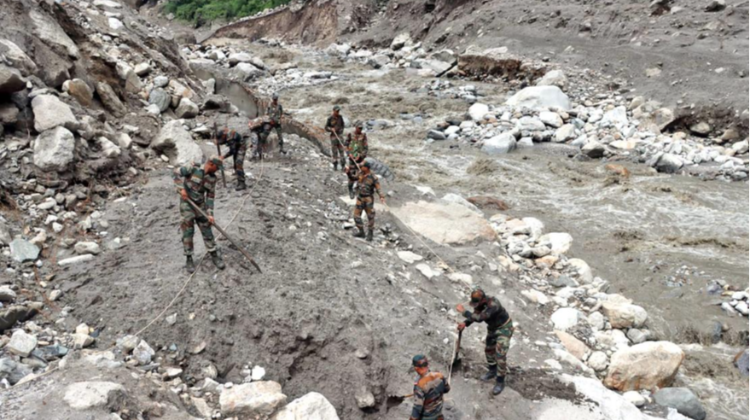Cloudburst Triggers Devastating Floods in Uttarakhand and Himachal Pradesh
- by amitava bose
- 2025-06-28
- 39 views

Lives lost, homes swept away, and infrastructure shattered as relentless rains wreak havoc in the Himalayan states
Tragedy has struck the hill states of Uttarakhand and Himachal Pradesh as a
series of cloudbursts and torrential rainfall triggered massive floods and
landslides, leaving a trail of destruction across popular tourist and
residential regions, including Manali, Kullu, and parts of Chamoli and
Rudraprayag.
In the early hours of Wednesday, a powerful cloudburst near Manali unleashed
a surge of water that swept away several homes, vehicles, roads, and bridges.
Visuals emerging from the affected areas show mangled remains of vehicles,
broken highways, collapsed buildings, and residents wading through chest-deep
water in search of safety.
Officials have confirmed that over two dozen lives have been lost so far,
with scores missing and feared trapped under debris. Rescue and relief
operations are underway at full scale, with the National Disaster Response
Force (NDRF), State Disaster Response Force (SDRF), Indian Army, and local
administration working around the clock to locate survivors and provide aid.
Temporary shelters have been set up in higher areas for those displaced.
Helicopters have been deployed for aerial surveys and evacuations, especially
in remote regions that are now cut off due to washed-out roads and bridges.
The Silent Pressure Beneath the Mountains
Experts have long warned that the fragile Himalayan ecosystem cannot
withstand rapid construction and unplanned development. The rampant building of
roads, tunnels, hotels, and dams in ecologically sensitive zones has placed
enormous stress on the land. In many areas, the mountainsides—already loose due
to deforestation—have crumbled under the pressure of the cloudbursts and heavy
rains.
Dr. Sameer Rawat, a geologist based in Dehradun, remarked, “The natural slope
and vegetation of the region have been compromised. When water accumulates
suddenly due to a cloudburst, there's no natural cushion left. The soil gives
way, and destruction follows.”
Tourism Comes to a Halt
The floods have severely impacted the summer tourism season, which peaks
during June and July. With Manali, Shimla, and other popular destinations now
inaccessible or under threat, thousands of tourists are stranded. Many hotels
have been damaged or submerged, and power and communication lines are down in
several towns.
The governments of both Uttarakhand and Himachal Pradesh have issued
advisories urging people to avoid non-essential travel to hill stations and
have declared several districts as disaster-affected zones.
Relief and Rebuilding: A Long Road Ahead
Chief Ministers of both states have announced immediate ex gratia relief to
the families of those deceased and injured. Central government aid has also
been promised, but authorities admit that rebuilding the damaged infrastructure
and restoring normalcy will take months—if not longer.
Prime Minister Narendra Modi tweeted his condolences and stated that every
possible support would be extended to the affected regions. Environmental
activists, meanwhile, are calling for a long-overdue review of construction
policies in Himalayan regions to prevent such disasters from becoming an annual
tragedy.
Public Support and Help Lines
Citizens are being urged to donate to official disaster relief funds.
Emergency helplines have been set up for missing persons, and disaster response
teams are prioritizing families with children, elderly, and medical needs.
As the rains continue, the situation remains critical. Authorities are on
high alert, and citizens are praying that the worst is behind them.









